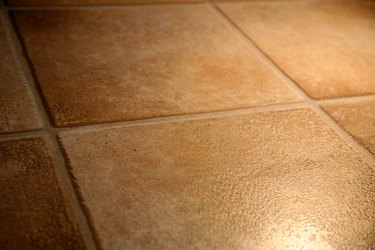
Ceramic tiles and porcelain tiles are common flooring options for bathrooms and kitchens because of their durable and attractive characteristics. Porcelain tiles differ from ceramic tiles in the temperatures that they are subjected to during the heating process. Both flooring types can be used in conjunction with radiant floor heating.
General Information
Video of the Day
Ceramic tiles and porcelain tiles are made from many of the same materials. The most substantial difference between them is the temperature at which they are heated during the kiln-firing process. The Porcelain Enamel Institute rating determines the traffic level that a tile flooring can endure, with the lowest rating of 0 for only light-traffic areas and the highest level of 5 being used for very high-traffic areas. Ceramic tiles usually have a rating between 0 and 3, while porcelain tiles often have a 5 rating.
Video of the Day
Ceramic Tile
Ceramic tiles are made from clay or a combination of clay and other materials. They are fired in a kiln. Ceramic tile may be glazed or unglazed. Glazed surfaces are slightly more likely to crack than unglazed surfaces. Ceramic tiles are typically bisque-fired at a low temperature before being glazed. This first-time firing process allows the tile to develop a stronger exterior and retain its shape. After being glazed, ceramic tiles are then fired in a kiln at about 2,100 degrees Fahrenheit.
Porcelain Tile
Porcelain tile is composed of small particles of clay, feldspar and silica. It is made from a finer clay than ceramic tile. It is a type of ceramic, but it is heated at higher temperatures that allow it to develop glasslike properties. Porcelain tile first is bisque-fired at a low temperature to keep it from shrinking during the final firing process. A glaze is applied. The porcelain is then heated in a kiln at about 2,650 degrees Fahrenheit. This higher temperature allows porcelain tile to develop a denser exterior that is more durable than ceramic tile. Porcelain is less likely to absorb moisture, is wear-resistant and stain-resistant.
Floor Heating
Ceramic and porcelain tile both provide an effective flooring for use with radiant floor heating. They don't expand or contract the way wood flooring does. They are resistant to cracking, and both conduct heat. Porcelain tile provides a slight advantage over ceramic tile when used with floor heating because of its greater durability and less likelihood of needing to be replaced.